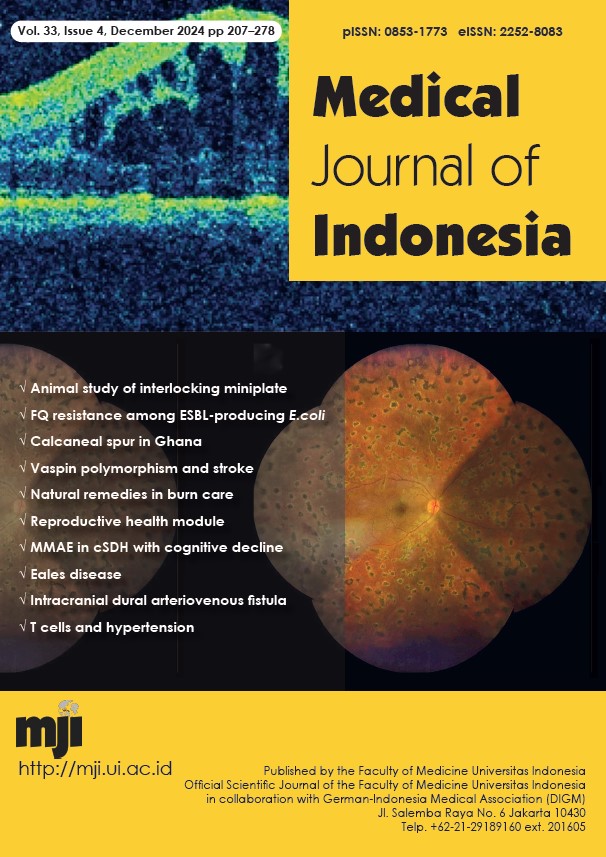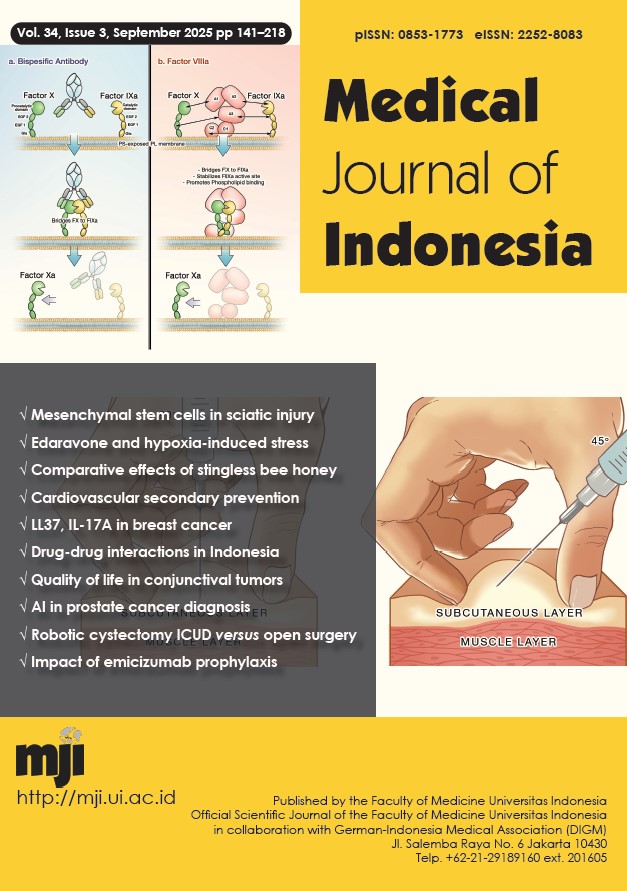Radiological and histological assessment of a novel interlocking three-dimensional miniplate for mandibular angle fractures: an animal study
DOI:
https://doi.org/10.13181/mji.oa.247567Keywords:
animals, bone plates, laboratory, mandibular fractureAbstract
BACKGROUND Open reduction and internal fixation are considered the gold standard for managing mandibular fractures, as they effectively restore anatomical structure and functionality. Three-dimensional (3D) miniplates were developed to obtain a geometrically stable structure. However, the rigid structure of 3D miniplate may cause screw holes to be located within the fracture lines or directly above important anatomical structures. Hence, we have developed customizable interlocking 3D miniplates that allow for modifications in the configuration of the horizontal miniplates and vertical cross-struts to meet specific requirements.
METHODS This study included 24 goats divided into 2 groups: interlocking 3D miniplate and standard plate. Each group was further divided into subgroups sacrificed on Days 5, 28, and 56. Radiological assessments were performed to evaluate bone, muscle, peri-implant bone, and peri-implant muscle density. Histological assessments were performed using Masson's trichome (MT) for bone healing evaluation and hematoxylin and eosin (H&E) staining for biocompatibility.
RESULTS Radiological assessment indicated an increase in density across all measured parameters from Day 5 to 56. Histological evaluation from MT staining showed a significantly higher fibrocartilage in the interlocking 3D miniplate group (6.109%, IQR 1.453–10.828) compared to standard plate (1.311%, IQR 0.636–2.553; p = 0.001). Furthermore, H&E staining showed significantly higher inflammatory cell counts in the standard group on Days 28 and 56 compared to the interlocking 3D miniplate group (p = 0.027).
CONCLUSIONS This study concluded that the interlocking 3D miniplate showed better bone healing properties and biocompatibility than the standard plate.
Downloads
References
Chatterjee A, Gunashekhar S, Karthic R, Karthika S, Edsor E, Nair RU. Comparison of single versus two non-compression miniplates in the management of unfavourable angle fracture of the mandible orginal research. J Pharm Bioallied Sci. 2023;15(Suppl 1):S486−9. https://doi.org/10.4103/jpbs.jpbs_555_22
Louis PJ, Morlandt AB. Advancements in maxillofacial trauma: a historical perspective. J Oral Maxillofac Surg. 2018;76(11):2256−70. https://doi.org/10.1016/j.joms.2018.08.021
Balani A, Saroj P, Kharsan V, Karan A, Mazhar H, Awasthy A. Management of mandibular angle and body fractures using miniplates and 3D plates. Bioinformation. 2024;20(6):605−9. https://doi.org/10.6026/973206300200605
Rastogi S, Paul S, Kukreja S, Aggarwal K, Choudhury R, Bhugra A, et al. Treatment of mandibular angle fractures with single three-dimensional locking miniplates without maxillomandibular fixation: how much fixation is required? Craniomaxillofac Trauma Reconstr. 2017;10(3):188−96. https://doi.org/10.1055/s-0037-1600904
Das MK, Mishra M, Singh G, Mondal S. Single linear miniplate versus rectangular grid plate in the treatment of mandibular angle fractures: a prospective, clinico-radiographic, comparative study. Natl J Maxillofac Surg. 2023;14(1):47−54. https://doi.org/10.4103/njms.njms_129_22
Singh A, Arunkumar KV. Standard 3D titanium miniplate versus locking 3D miniplate in fracture of mandible: a prospective comparative study. J Maxillofac Oral Surg. 2016;15(2):164−72. https://doi.org/10.1007/s12663-015-0817-y
Yadav A. Principles of internal fixation in maxillofacial surgery. In: Bonanthaya K, Panneerselvam E, Manuel S, Kumar VV, Rai A, editors. Oral and maxillofacial surgery for the clinician. Singapore: Springer; 2021. p. 1039−51. https://doi.org/10.1007/978-981-15-1346-6_51
Kreshanti P, Supriadi S, Kekalih A, Rahyussalim AJ, Priosoeryanto BP, Noviana D, et al. Novel design of interlocking 3-dimensional miniplate in mandibular angle fractures: an in vitro study. J Craniofac Surg. 2024;35(5):1591−6. https://doi.org/10.1097/SCS.0000000000010372
Marcus HJ, Bennett A, Chari A, Day T, Hirst A, Hughes-Hallett A, et al. IDEAL-D framework for device innovation: a consensus statement on the preclinical stage. Ann Surg. 2022;275(1):73−9. https://doi.org/10.1097/SLA.0000000000004907
Orassi V, Duda GN, Heiland M, Fischer H, Rendenbach C, Checa S. Biomechanical assessment of the validity of sheep as a preclinical model for testing mandibular fracture fixation devices. Front Bioeng Biotechnol. 2021;9:672176. https://doi.org/10.3389/fbioe.2021.672176
Wancket LM. Animal models for evaluation of bone implants and devices: comparative bone structure and common model uses. Vet Pathol. 2015;52(5):842−50. https://doi.org/10.1177/0300985815593124
Alizadeh S, Kamfar P, Hosseinchi M. Evaluation of radiological and anatomical features of skull bones in adult Saanen goat. Vet Med Sci. 2024;10(3):e1435. https://doi.org/10.1002/vms3.1435
Al-Tairi NH, Shoushan MM, Saad Khedr MM, Abd-alal SE. Comparison of three-dimensional plate versus double miniplate osteosynthesis for treatment of unfavorable mandibular angle fractures. Tanta Dent J. 2015;12(2): 89-98. https://doi.org/10.1016/j.tdj.2015.02.001
Published
How to Cite
Issue
Section
License
Copyright (c) 2025 Prasetyanugraheni Kreshanti, Deni Noviana, Bambang Pontjo Priosoeryanto, Aria Kekalih, Rahyussalim, Sugeng Supriadi, Mendy Juniaty Hatibie, Chaula Luthfia Sukasah

This work is licensed under a Creative Commons Attribution-NonCommercial 4.0 International License.
Authors who publish with Medical Journal of Indonesia agree to the following terms:
- Authors retain copyright and grant Medical Journal of Indonesia right of first publication with the work simultaneously licensed under a Creative Commons Attribution-NonCommercial License that allows others to remix, adapt, build upon the work non-commercially with an acknowledgment of the work’s authorship and initial publication in Medical Journal of Indonesia.
- Authors are permitted to copy and redistribute the journal's published version of the work non-commercially (e.g., post it to an institutional repository or publish it in a book), with an acknowledgment of its initial publication in Medical Journal of Indonesia.






































